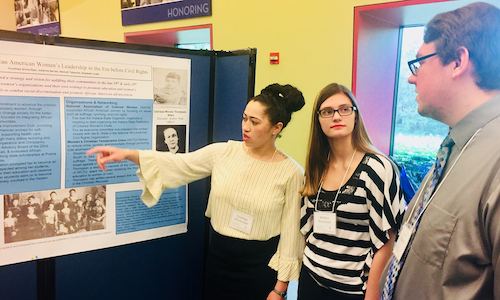
Not all leaders seek the limelight. But it doesn’t mean they shouldn’t be brought out of the shadows.
“Unsung Heroes: African American Women’s Leadership in the Era before Civil Rights,” a student research project in History Professor Georgina Hickey’s Women in Leadership course, highlights the social change work of four relatively unknown women in the 19th and early 20th centuries. The class researched the lives of Clarissa Minnie Thompson Allen, Mary “Mamie” P. Burrill, Lillian Parker Thomas Fox and Laura A. Moore Westbrook.
“Not everyone is going to be the face of a movement, but that doesn’t mean you aren’t making a difference. Actually, these women made a large impact in their circles,” said senior Courtney Grove-Dyer. “They were on the ground, supporting the people who were in the public eye. It was part of the strategy.”
The women were linked to high-profile suffrage and civil rights movement activists like Ida B. Wells and W.E.B. Du Bois, according to secondary sources. But outside of a name, not much other information was known.
“These women’s names came to us because they were included in a photographic collection that landed at the Library of Congress. Their names have been vaguely associated with suffrage. But the question is how did they get there and what have they done?” Hickey asked. “That is what the students set out to find.”
The eight students, who worked in groups of two, presented their findings at the campus-hosted 26th Meeting of Minds and at the Donor Celebratory events in May.
The biographies also will be published this fall in the Online Biographical Dictionary of the Woman Suffrage Movement in the United States. The online journal and database is organized by award-winning historical researcher Thomas Dublin, who co-directs the Center for the Historical Study of Women and Gender at Binghamton University in New York. Hickey regularly partners with Dublin on database research and he provides the names for the Women in Leadership course research project.
Grove-Dyer and senior Brittany Richmond spent nearly four months uncovering pieces about Laura A. Moore Westbrook’s life. Research involved in-depth engagement with a variety of primary sources, including newspapers, photographs, census records and organizational documents.
When the project began, they thought writing a 500-word biography would be relatively simple. But then the duo realized how labor-intensive the research process could be.
“When it took us a month to find a death year—not a date, a year—the importance of our work really hit me,” said Richmond, who found a brief mention of Westbrook’s 1894 death announcement in a library’s newspaper archive collection in Texas. They looked into Texas resources after learning she resided there. “The mention we found didn’t say how she died or give a date. But we were able to identify a year by the paper’s publication date.”
In their research, the team learned that Westbrook encouraged her chapter of the Women’s Christian Temperance Union to be the first chapter in the South to officially endorse women’s suffrage. She also served on a Texas governmental advisory board where she evaluated scholarship applications to Prairie View A&M University, the first state-supported college for African Americans.
Grove-Dyer said even with each woman’s different backgrounds and histories, the class noticed that the four female activists developed similar themes and tactics, lecturing and writing about important issues they encounter.
“They developed a vision for uplifting their families and communities, understanding suffrage and education as tools to combat racial discrimination and promote African American advancement,” she said. “They weren’t looking for recognition; they were organizers looking to advance human rights. And I think there is something that we can all learn from that too.”





